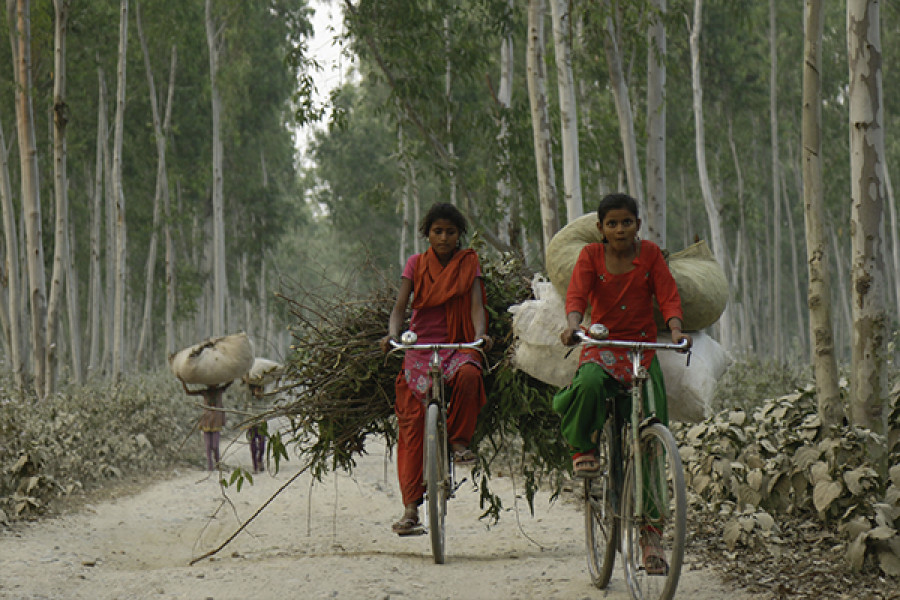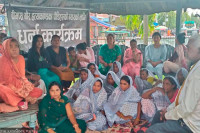National
Timber collection ban discourages user groups from continuing conservation
Due to restrictions, community forest users are in trouble and they have lost their valuable source of income.
Chandan Kumar Mandal
For Ram Sapkota, a farmer in Gaindakot Municipality, Nawalpur, feeding his 10 goats and four cows has been a challenge in the last few months, especially since the government imposed restrictions on movement amid the Covid-19 pandemic.
Sapkota blames it on the scarcity of firewood in his village.
“I couldn’t buy cooking gas cylinders during the lockdown. Also, a farmer like me can’t afford to use cooking gas to cook fodder for my cattle,” Sapkota, told the Post over phone. “I had been using whatever wood I found around the house and relied on my biogas plant to cook food for my family.”
Like Sapkota’s family, thousands of households across the country that depend on firewood to feed themselves and their cattle find themselves in a difficult situation after the government on May 28 imposed a ban on felling of trees and the collection, transportation and sale of timber from forests, following complaints that trees were being cut haphazardly and illegally in the name of “scientific forest management”.
“In the past, local farmers and members of marginalised groups would get to collect firewood, timber and other products from the forest every year,” said Sapkota, who has been a member of Sundari Community Forest Users Group for nearly 25 years.
“We would collect fallen wood and other products and pay cheaper prices compared to that of the market. This time, we have been deprived of anything from our forest.”
But this year, farmers like Sapkota, who have worked day and night to take care of the forest turning barren land into green cover, haven’t been allowed to collect wood.
Sapkota, who would get firewood at Rs 2 per kg from the forest, now has to buy at Rs 25 from the local sawmills.
“With no cash income, I can’t buy firewood from the market,” said Sapkota. “First, the lockdown came as a threat to our health and then the government ban on timber has affected our livelihood as this year we could not get anything from our forest.”
Following reports of illegal felling of trees in the name of scientific forest management, the government imposed a nationwide ban, which was relaxed on June 10, to allow the cutting of trees except for saal (shorea robusta).
However, the damage has been done.
“Although the government ban is now only on saal timber, local communities have been unable to use other forest products either,” said Bharati Kumari Pathak, chairperson of Federation of Community Forestry Users’ Nepal, the umbrella organisation of forest user groups. “There are some that need the wood to make their cowsheds, others need timber to rebuild their quake-affected houses. The government’s abrupt decision to ban the felling of trees and haphazard implementation of the rule by local officials hurt communities.”
The struggle for forest products is no different for nearly 850 households associated with Shiva Community Forest Users Group, Kawasoti.
Every day, locals visit Hari Subedi, joint secretary of the group, to ask him when they can get firewood or timber for which they applied months ago.
“We have been hearing complaints from locals every day. We have been unable to provide firewood even for religious occasions such as cremation of the dead, let alone for cooking,” said Subedi.
The government ban on felling of trees has left a similar impact on other parts of the country as well.
While various parliamentary committees and government panels have started investigating the rampant deforestation that led to the ban, valuable timber worth millions have been left to decay. In the absence of locally-harvested timber, consumers are compelled to buy wood for construction and other purposes at exorbitant rates.
With the permission of the local forest authority, community forests start harvesting forest products from January-February before the window closes at the end of May.
This year, however, the window period was marred first by the nationwide lockdown and then government ban on selling of timber imposed from May.
The government decisions have not only affected households, they have also hampered forest groups’ income, and ultimately their conservation efforts.
The Community Forestry Guidelines, 2014, saus that community forest users’ groups have to spend their earnings on forest development (25 percent), poverty eradication and livelihood (35 percent) and on social development (40 percent) programmes.
Subedi’s community forest aimed to raise about five to six million by selling nearly 4,400 cubic feet of timber and other forest products. Last year, they had made nearly Rs 2.2million.
“The timber is lying in the forest. We have been unable to sell a single cubic feet of it,” said Subedi. “Nearly 150 families had applied months ago for wood, and they have been waiting since then.”
Nepal’s community forest system is a globally-recognised model of conservation that engages the local communities to conserve forests. Besides recovering the country's green coverage in the last two-and-half decades, these forest user groups have also contributed towards poverty alleviation.
Currently, 23,500 such groups manage over 2.5 million hectares of forest, around 34.5 percent of the national forest cover, benefiting over 3.2 million households across the country.
But concerns are growing of late that the community forests may not sustain themselves due to three levels of taxes on them and the ban on selling of forest yield at a crucial time of the trade season.
Community forest members fear that if people are not allowed to utilise their forest resources that they protected for years, they would be discouraged to actively participate in forest conservation.
According to Subedi and Sapkota, the government should have investigated areas where trees were cut rampantly instead of imposing a blanket ban.
While the timber lays in the forest, Subedi has been struggling to pay salaries for three staff members as the group’s income has dwindled following the ban.
After years of work, families associated with Shiva Community Forest Users Group in Kawasoti had turned an empty and encroached area on the northern side of the East-West Highway, into a forest covering 104 hectares with valuable trees and wildlife.
“This season, we had cleaned the forest and also mobilised resources to protect it from wildfires,” said Subedi. “But when we needed money and the locals needed wood, we can’t have it. Why would people give their blood and sweat to conservation if they can’t use the forest’s resources when they need them the most?”




 6.3200000000001°C Kathmandu
6.3200000000001°C Kathmandu








%20(1).jpg&w=300&height=200)






